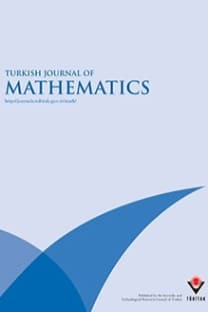Threshold complexes and connections to number theory
Quota system, threshold complex, persistent homology, Goldbach conjecture, Riemann Hypothesis, random complexes
Threshold complexes and connections to number theory
Quota system, threshold complex, persistent homology, Goldbach conjecture, Riemann Hypothesis, random complexes,
___
- Apostol, T. M.: Introduction to Analytic Number Theory, Undergraduate Texts in Mathematics, New YorkHeidelberg: Springer-Verlag 1976.
- Billingsley, P.: Probability and Measure, Wiley, New York 1986.
- Bj¨ orner, A.: A cell complex in number theory, Advances in Applied Math., 46, 1-4: 71-85 (2011).
- Bj¨ orner, A., Kalai, G.: On f-vectors and homology, Annals New York Academy of Sciences, 555: 63-80 (1989). Borwein, J., Bailey, D., Girgensohn, R.: Experimentation in Mathematics: Computational Paths to Discovery, A K Peters, Wellesley, MA 2004.
- Edelsbrunner, H., Harer, J.: Persistant homology - a survey. In Surveys on Discrete and Computational Geometry, volume 453 of Contemp. Math, pages 257-282. Amer. Math. Soc., Providence RI 2008.
- Hatcher, A.: Algebraic Topology, Cambridge University Press, Cambridge 2002.
- Howell, K. B.: Principles of Fourier Analysis, Chapman & Hall/CRC, Boca Raton, FL 2001.
- Kahle, M.: Random Geometric Complexes, Discrete Comput. Geom 45, 555-573 (2011).
- Kahn, J., Saks M., Sturtevant, D.: A topological approach to evasiveness, Combinatorica 4 297-306 (1984).
- Latouche, G., Ramaswami, V.: Introduction to Matrix Analytic Methods in Stochastic Modelling, 1st ed. Chapter 1: Quasi-Birth-and-Death Processes; ASA SIAM 1999.
- Munkres, J. R.: Elements of Algebraic Topology, Addison-Wesley, Menlo Park, CA 1984.
- Pakianathan, J., Yalcin, E.: On nilpotent ideals in the cohomology ring of a finite group, Topology 42, 1155-1183 (2003).
- Taylor, A., Pacelli, A.: Mathematics and Politics: Strategy, Voting, Power and Proof, 2nd ed. Springer, NY 200 Taylor, A., Zwicker, W.: A characterization of weighted voting, Proc. Amer. Math. Soc., Vol 115, Number 4, 1089-1094 (1992).
- Tenenbaum, G.: Introduction to Analytic and Probabilistic Number Theory, Cambridge University Press, Cambridge 1995.
- Titchmarsh, E .C.: The Theory of the Riemann Zeta-Function, 2nd ed. revised by D.R. Heath-Brown, Oxford University Press, New York 1986.
- ISSN: 1300-0098
- Yayın Aralığı: 6
- Yayıncı: TÜBİTAK
On the existence of (400, 57, 8) non-abelian difference sets
Yaşar POLATOĞLU, Hatice Esra ÖZKAN, Emel DUMAN YAVUZ
Erratum to: ``Null Mannheim curves in the Minkowski 3-space E13''
The total graph of a finite commutative ring
Structure theorems for rings under certain coactions of a Hopf algebra
On the non-propagation theorem and applications
Nassim ATHMOUNI, Mondher DAMAK
Threshold complexes and connections to number theory
Jonathan PAKIANATHAN, Troy WINFREE
Commutants and hyper-reflexivity of multiplication operators
Karim HEDAYATIAN, Masoumeh FAGHIH-AHMADI
Gorenstein transpose with respect to a semidualizing bimodule
